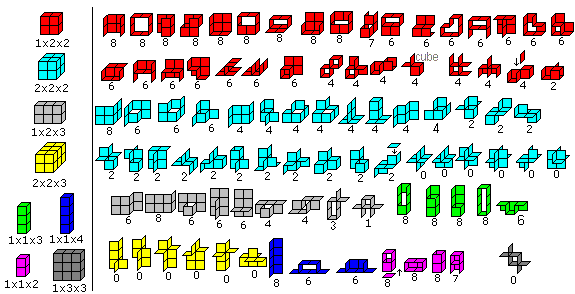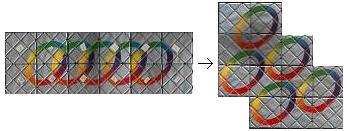|
What is Rubik's Magic? top
... ... ... |
Rubik's Magic is a folding game for one person.
A rectangle of 4x2 squares is to be changed to a six-cornered
polygon in heart shape by a sequence of foldings.
At the same time three separate rings change into three
linked rings on the reverse side. |
... ... ... |
The first Magic of Matchbox from the 1980s is black and
has the same rings. They are more beautiful because of the
rainbow colours.
The black Magic rectangle stands on its head compared
with the red one.
|
Description top
.. .... .... |
When you buy Rubik's Magic, you get it as a 4x2-rectangle
with the three rings. After several random foldings some squares lie on
each other. If you stretch Magic you find strange three-dimensional configurations.
Sometimes squares even penetrate each other. |
... ... ... |
.. .... .... |
If you put a rectangle on its head, it looks the same.
If you take into account the writing "Rubik's Magic", you can say: Magic
stands upright, if the words stand upright. The black Magic stands upright,
if the words stand upside down. |
... ... ... |
The reverse side of Magic has disordered squares.
There is one unique square: It has three arcs. Here it
is marked yellow.
If you have solved Magic, this square goes into the centre. |
If you play with Magic and you want to control your movings,
you can look at the three-arcs-square (Book 3).
I prefer numbering the squares (Similar to book 2).
... ... ... |
I suggest numbering the squares as shown at the drawing
on the left. Then there is a ring with eight squares, where the numbers
stand upright. |
... ... ... |
The centre diamond
... ... ... |
This is important to understand the following sequences:
The 4x2-rectangle has a diamond formed by groves on four
squares on both sides.
If there are strings in it, it is drawn as shown on the
right. |
... ... ... |
Sequences top
If you have mixed the Magic up, you must try to find
any 4x2 rectangle.
If you succeeded, you should try the following sequences.
Ring

|
You quickly find out: You can open each rectangle to
a ring. |
Changing
the rows (Sequence A)

This sequence has the effect that two lines interchange.
The writing "Rubik's Magic" stands horizontally as before.
If you repeat the sequences you return to the start pattern.
The sequence has the order 2. - The moves are reversible.
Turning
the squares (Sequence B)
 The squares are ordered in another
way at the same time. The writing "Rubik's Magic" stands horizontally
before and vertically after making the moves.
The squares are ordered in another
way at the same time. The writing "Rubik's Magic" stands horizontally
before and vertically after making the moves.
If you repeat the sequences you return to the start pattern.
The sequence has the order 2. - The moves are reversible.
Transformation

By the way: The right 2x2 square doesn't move during this
procedure.
All Patterns
of Eight Squares top
... ... ... |
How many patterns can you make with the squares?
First observation: The sequence of the squares 1 to 8
is kept at every pattern.
There are four main patterns (left row), which turn into
each other by the given sequences A and BAB.
You can find three more to every main pattern by using
the main squares and the sequences below. |

There are 16 patterns of the 4x2 rectangle.
... ... ...
|
If you perform B at any 4x2 rectangle, you get different
2x4 rectangles.
Thus there must also be 16 rectangles of this kind.
|
Result: There are 32 patterns of 8 squares altogether.
A Solution top

First Step

|
Change the basic rectangle to a rectangle with 1 in the
right corner at the second row. |
Second Step

|
Turn the rectangle as shown on the left. Use the tansformation. |
Transformation


A shorter
Solution
... |
 ... ... |
Use a "mirror" version of the transformation for the
heart shaped form. You get the rectangle with the three rings by the sequences
B and C1.
The reverse path is a solution. |
The Mechanism
of Folding top
The first impression is that every piece has two hinges
like the Jacob's ladder toy. This is partly right. The mechanism is more
complicated however.
If you lay two squares on top of each other, then a new
hinge appears at the right angle to the old hinge. |
... ... ... |
Where the hinge is depends on folding up or down. In the
drawing strings are on the top in front.
The Labyrinth
of Strings top
... ... ... |
Two adjacent squares are connected with strings, actually
by two rings of fishing line. You see them running in grooves partly in
front or behind the squares. If you lay two squares on top of each other,
then strings jump into empty grooves of the opposite square. |
The following description
refers to the ring with the ordered squares.
... ... ...
|
The eight squares are connected by 2x8 strings.
One pair of rings goes through three squares. |
There are four strings in the grooves of squares 1,3,5, and
7, and there are two strings in the grooves of the squares 2,4,6, and 8.
The squares are not of the same kind. If a string gets snarled up in one
place (it can happen!), you can cut one string in a groove, which has two
strings, and remove it. You can fold Magic in spite of that, in fact it
is even better. But don't cut the strings without having to do so. Better
safe than sorry.
Shapes top
Double square-figures
... ... ... |
There are also the plane shapes on the left, which you
can form with 4+4 squares. The T-form is missing.
If you stretch these shapes you find different 3D configurations.
"L" especially is productive. |
Though the sequence 1 to 8 is kept, strange shapes will develop,
because the squares penetrate (also several times) each other.
Cube
Folding the cube is a special challenge.
... ..
Be careful!. ..
Be careful!.
|
1 Start with the heart-like shape. Fold at the red lines.
2 Spread out the figure uand turn it at the same time.
Watch at valleys and mountains.The two squares above stay above. The three
right squares turn in direction of the arrows.
3 A cube arises.
4 You can lift the square at the top and you get a basket. |
 |
... ... ... |
The cube is nicer, if it stands on two squares.
The dark blue lines give the position of the hinges.
But the way to figure 1 is long... (Book 3) |
Symmetric
Cubic Shapes
There are many shapes, which you can find by accident.
I restrict myself to symmetrical shapes, the squares of which are perpendicular
to each other and which have no double walls because of their multitude
and their "beauty".
 I ordered the shapes from two points of view:
I ordered the shapes from two points of view:
(1) The colour indicates the smallest rectangular solid
(on the left) you can lay round the shape ("wrapping solid").
(2) The number below the shape is the number of the squares
the solid and the shape have in common.
Did I find all shapes?
Polyominoids top
You call figures of connected squares lying in cubic
lattices polyominoids .
Jorge L. Mireles Jasso worked on these figures. He offers
a program on the internet, which can find, show and count polyominoids
(URL see below). I used this program for figures with eight squares because
of Magic. You get the large number of 207265 figures, which are ordered
by the form of the wrapping rectangular solid.
You can find much fewer shapes
with Magic. There is a considerable reduction. You can explain that by
square 3, which is in place of one of the eight squares.
1st reduction:

|
Each square has exactly two neighbour squares. |
This means the sequence of the squares is kept.
2nd reduction:
... ... ... |
In Magic there are only four places for a neighbour
square. Square 4 "rolls" around square 3. |
... ... ... |
Theoretically there are 16 possibilities for laying square
number 4 to square number 3. If you turn number 4, you even get 32 cases.
Impossible Figures
top
... ... ...
|
It is easy to understand that this figure can't be solved
with Magic. There is no chain. Square 3 has no second neighbour.
 |
The next case is difficult
to investigate.
Rule:
Go around the figure in a closed line. Start at a square
and go back to it. Calculate a sum step by step. Start with nought.
>If you leave a square having four strings and
go to the right, add 1. If you go to the left, subtract 1.
>If you leave a square having two strings and
go to the right, subtract 1. If you go to the left, add 1.
>If you go straight, the sum doesn't change.
If the sum is 0 in the end, the figure is possible with
the 4x2-Magic.
... ... ...
|
Here the sum is 4 (-4 respectively)

 |
Rubik's
Magic Master Edition
top
. .. ..
|
There is a version of Magic with 12 squares in black
or grey. You can transfer moves, but there are also new ones. The figures
are more complicated.
You can find a solution of the problem on the left in
Christian Eggermont's Homepage. He has the black Magic. You must turn the
grey Magic at the beginning, so that the writing is upside down. |
Purchase of
Rubik's Magic
top
In Germany you can buy Rubik's Magic in good toy shops.
You pay about 10€ (2004).
Copyright Jumbo International, Amsterdam. "Rubik's Cube
is a trademark of Seven Towns Ltd. used under licence".
Rubik's
Magic on the Internet top
German
Achtziger-forum
Rubik's
Magic
Ronald Bieber
Lösung
Wikipedia
Rubik's
Magic
English
Christian Eggermont
Rubik's
Magic
Jaap Scherphuis
Rubik's
Magic Main Page
Maurizio Paolini
A
new topological invariant for the "Rubik's Magic" puzzle
Symmetric
polyominoid configurations
How
to solve Rubik's Magic (Youtube)
Wikipedia
Rubik's
Magic
Youtube
Rubiks
Magic 3 Solutions,
How
to solve a Rubik's Magic,
Rubik's
Magic average 0.86s (Super slow).wmv,
Fixing
a 'Scrambled' Rubik's Magic,
How
to Solve and Re-Scramble Your Master Magic,
Attempting
to Solve the RUBIK'S MAGIC (With NO HELP),
References top
(1) Christoph Bandelow: Rubik's magische Ringe, Niedernhausen/Ts.
1986
(2) Ashwin Belur, Blair Whitaker: Rubik's Magic, München
1986
(3) James G. Nourse: Simple Solutions to Rubik's Magic,
New York 1986
(4) Wolfgang Glebe: Mathematische Spielereien, Wissenschaftsmagazin
der TU Berlin Heft 10, 1991, Seite 94ff.
Feedback: Email address on my main page
This
page is also available in German.
URL of
my Homepage:
https://www.mathematische-basteleien.de/
©
2000 Jürgen Köller
top |





 ...
... ...
... ...
... ...
...
 ...
...
 ...
...

 ...
... ...
... ...
... ..
..
 ...
... ...
... ...
... ...
... ...
... ...
... ...
... ..
..